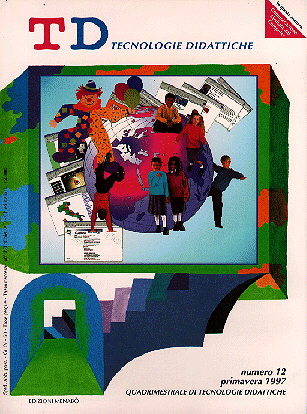How did they use it? The involvement of computer science students in a CMC environment created for distance learning
Main Article Content
Abstract
Discussion of the involvement of computer science students in a Computer Mediated Communucation created for distance learning. The different possibilities 'use of CMC to distance education and the reasons for doing so: Learning, Motivation, Socialist.' What 'more' important for students?
Article Details
Section
Articles - Special Issue

This work is licensed under a Creative Commons Attribution-NonCommercial 4.0 International License.
Authors who publish with this journal agree to the following terms:
- Authors retain copyright and grant the journal right of first publication with the work simultaneously licensed under a Creative Commons Attribution-NonCommercial 4.0 International License.
- Authors are able to enter into separate, additional contractual arrangements for the non-exclusive distribution of the journal's published version of the work (e.g., post it to an institutional repository or publish it in a book), with an acknowledgement of its initial publication in this journal.
- Authors are permitted and encouraged to post their work online (e.g., in institutional repositories or on their website) prior to and during the submission process, as it can lead to productive exchanges, as well as earlier and greater citation of published work (See The Effect of Open Access)
References
Berge Z., L. (1995), “Facilitating Computer Conferencing: Recommendations From the Field”, Educational Technology, Vol. 35, Number 1.
Goodyear P., Steeples C., (1994), “Computer-mediated communication in the professional development of workers in the advanced learning technologies industry”, Eccleston J., Barta B., Hambusch R (eds). The computer-mediated education of information technology professionals and advanced endusers, Elsevier: Amsterdam.
Issroff K., del Soldato,T. (1996) Incorporating motivation into computer supported collaborative learning. Euro AIED Lisbon, October, 1996.
Mason R., Kaye A., (1989) Mindweave, Pergamon Press, Oxford.
Mayes T., Coventry L., Thomson A., Mason R., (1994) “Learning through Telematics”. A Learning Framework for Telecommunication Applications in Higher Education, The Institute for Computer Based Learning & The Open University, for British Telecom. Report ref E31/E33.
Ruggles C., Underwood J., Walker D., (1995). “STILE: A Hypermedia approach to the provision of a Flexible, Interdisciplinary Resource base for teaching and learning”. Innovations in Education and Training International, 1995, vol. 32(3), 209-219.
Ruggles C., (1995). “STILE: the growth of a flexible, interdisciplinary resource base for open learning”. In World Conference on Computers in Education VI: WCCE95, Liberating the learner, J David Tinsley and Tom J van Weert, (eds), Chapman and Hall, 1995, pp 899-906.
ShedletskyL., (1993), ‘Minding ComputerMediated Communication: CMC as Experiential Learning’, Educational Technology, Vol. 33 (12).
Steeples C., Goodyear P., Mellar H., (1993), ‘Flexible Learning in Higher Education: The use of Computer-Mediated Communications’, Computers and Education, Pergamon Press.
Underwood J., Dahlberg A., FitzPatrick S., Greenwood M. (1996). ëA STILE Project case study: the evaluation of a computer-based visual key for fossil identificationí. Association for learning Technology Journal, ALT-J, Vol. 4 (2).
Velayo R., S. (1994), ‘Supplementary Classroom Instruction via Computer Conferencing’, Educational Technology, Vol. 34 (5).
Whitelock D., Scanlon E. (1996). Motivation, Media and Motion: Reviewing a Computer Supported Collaborative Learning Experience. Euro AIED Lisbon, October, 1996.
Wilson T., Whitelock D., (1996). “Piloting a new approach; Making use of new technology to present a distance learning computer science course”. Association for Learning Technology Journal (ALT-J), Vol. 4 (1).
Zhao Z., Cook J., Higgen N. (1996). “Online learning for design students”. Association for Learning Technology Journal (ALT-J), Vol. 4 (1).
Goodyear P., Steeples C., (1994), “Computer-mediated communication in the professional development of workers in the advanced learning technologies industry”, Eccleston J., Barta B., Hambusch R (eds). The computer-mediated education of information technology professionals and advanced endusers, Elsevier: Amsterdam.
Issroff K., del Soldato,T. (1996) Incorporating motivation into computer supported collaborative learning. Euro AIED Lisbon, October, 1996.
Mason R., Kaye A., (1989) Mindweave, Pergamon Press, Oxford.
Mayes T., Coventry L., Thomson A., Mason R., (1994) “Learning through Telematics”. A Learning Framework for Telecommunication Applications in Higher Education, The Institute for Computer Based Learning & The Open University, for British Telecom. Report ref E31/E33.
Ruggles C., Underwood J., Walker D., (1995). “STILE: A Hypermedia approach to the provision of a Flexible, Interdisciplinary Resource base for teaching and learning”. Innovations in Education and Training International, 1995, vol. 32(3), 209-219.
Ruggles C., (1995). “STILE: the growth of a flexible, interdisciplinary resource base for open learning”. In World Conference on Computers in Education VI: WCCE95, Liberating the learner, J David Tinsley and Tom J van Weert, (eds), Chapman and Hall, 1995, pp 899-906.
ShedletskyL., (1993), ‘Minding ComputerMediated Communication: CMC as Experiential Learning’, Educational Technology, Vol. 33 (12).
Steeples C., Goodyear P., Mellar H., (1993), ‘Flexible Learning in Higher Education: The use of Computer-Mediated Communications’, Computers and Education, Pergamon Press.
Underwood J., Dahlberg A., FitzPatrick S., Greenwood M. (1996). ëA STILE Project case study: the evaluation of a computer-based visual key for fossil identificationí. Association for learning Technology Journal, ALT-J, Vol. 4 (2).
Velayo R., S. (1994), ‘Supplementary Classroom Instruction via Computer Conferencing’, Educational Technology, Vol. 34 (5).
Whitelock D., Scanlon E. (1996). Motivation, Media and Motion: Reviewing a Computer Supported Collaborative Learning Experience. Euro AIED Lisbon, October, 1996.
Wilson T., Whitelock D., (1996). “Piloting a new approach; Making use of new technology to present a distance learning computer science course”. Association for Learning Technology Journal (ALT-J), Vol. 4 (1).
Zhao Z., Cook J., Higgen N. (1996). “Online learning for design students”. Association for Learning Technology Journal (ALT-J), Vol. 4 (1).

